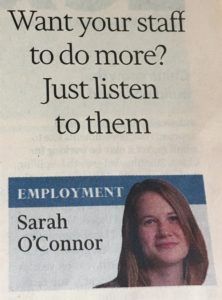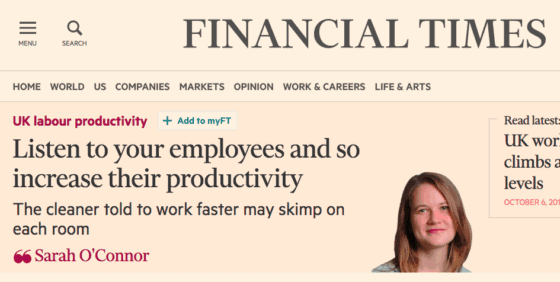 When I was in England on vacation recently, I saw this column in the Financial Times:
When I was in England on vacation recently, I saw this column in the Financial Times:
Listen to your employees and so increase their productivity
And the author, Sarah O'Connor, makes a great point in the sub headline – that just asking people to work faster might mean quality suffers. As leaders, in a factory or a hospital or a software company (or whatever), you can't just demand better results.
Look at what happened at Wells Fargo.
She points out an economist (or I'd add a Lean thinker) would assume boosting productivity would come through better training or other systemic factors that would make it possible for people to do more.
Not everyone has this view… some think they can just pressure the workers.
“For the hotel owner — at least for the one I interviewed in the UK recently — it means telling the cleaning staff to clean more rooms per hour.”
Telling people to work harder without properly supporting them can lead to all sorts of problems like this:
What Makes a Person Clean Drinking Glasses with Pledge? A Bad System
Leaders need to, instead, work with employees to reduce waste, making work easier and, therefore, making it more possible to clean more rooms per hour.
That's how Toyota helped a food bank serve more meals per hour… making the work easier and engaging people.
O'Connor also wrote:
“This hotel owner is not an outlier. When the Resolution Foundation think-tank surveyed 500 employers this year about how they planned to respond to the rising minimum wage, “ask workers to do more” was the second-most common response after “increase prices”, beating ideas like investing in training or technology.”
Asking people to do more can lead to problems. Just raising prices to try to make up for higher costs can cause problems too.
I've blogged about this a lot in the past. One example from 10 years ago, when I wrote about this topic more:
See more about this (with a reference to Toyota's Taiichi Ohno and his book Workplace Management via Gemba Academy):
Traditional business thinking looks at an organization's costs and their desired profit margins… they tack on margin to the cost to set a price. This often loses sight of the very practical idea that prices are set by the market.
Just because one of your input costs goes up (labor, materials, etc.) doesn't mean you're entitled to raise prices.
Lean thinking, going way back in Toyota's history, emphasizes that if one of your input costs goes up, you have to challenge yourself to find other cost reductions to make up for it.
If you raise prices, you might get away with that in the short term. Over time, customers will find alternatives, including finding ways to use less of your product because the cost is too high.
It's Lean thinking and basic microeconomics. You don't get to just raise prices because you want to or you think you “have to.” But, it's a common business practice even in modern times.
As she ends the column:
“Of course, an economy's productivity is shaped by more than just what happens inside companies. But employers could still use a little more imagination. You do not need shiny robots in order to redesign work in small but useful ways. A good first step would be to ask employees for ideas. One office cleaning company has replaced the individual bins under people's desks with a few central ones per room, making it quicker for the cleaners to empty them.
Productivity has to mean working smarter, not harder. Otherwise, we are simply running to stand still.”
Asking employees for ideas is a good start. THEN, you need to be a collaborative leader to help them test the ideas in the Plan -Do – Study – Adjust and Kaizen approaches.
This requires coaching and discussion. In the example from O'Connor's piece, I'm not sure that the countermeasure from housekeeping isn't suboptimizing.
Central trash bins certainly makes it easier for the cleaning company. But, let's say that's a law firm — is it a good use of lawyer time to walk to a trash bin instead having one at their desk?
Effective Kaizen isn't suboptimizing. If we accidentally do something suboptimizing, you should learn from it and Adjust. Plan, Do, Study, Adjust. Or, you talk through the situation and realize it's not customer focused for the trash company to make it harder for their customers to throw out trash.
We see this principle in reverse when good healthcare materials management teams recognize that it's wrong to make nurses walk down a long hallway to a central utility room and inventory location. Materials management should spend more time restocking to more locations to make it easier for nurses and to save nurse time.
Maybe that's easier to sort out when you're just setting budgets in an organization. Working with an outsourced cleaning company is more complicated. If you're making them do “more work,” they're going to want to charge you a higher price (and maybe that's not a good idea for them, either).
The cleaning company should find a way to make their work easier, to improve productivity, in a way that doesn't cause problems for their customers?
What do you think?
What do you think? Please scroll down (or click) to post a comment. Or please share the post with your thoughts on LinkedIn – and follow me or connect with me there.
Did you like this post? Make sure you don't miss a post or podcast — Subscribe to get notified about posts via email daily or weekly.
Check out my latest book, The Mistakes That Make Us: Cultivating a Culture of Learning and Innovation:











The cleaning company example hits home for me as I’ve noticed this as a problem in our office. The problem goes beyond emptying the waste bin. Consider sweeping or vacuuming under a desk with a bin on the floor. How do you do it? Move the bin, sweep, replace the bin? For forty offices that’s a lot of handling of bins, most of which are empty or nearly so. I cane in early one morning to witness how it was done and saw three huge dirty warehouse garbage cans being dragged through the office just to collect recycling and trash bins. Did anyone ever think of the work? No. Only the result they wanted – a clean office.
“Easier better faster cheaper, in that order” -Shigeo Shingo
Smaller bins that hung on desks so sweeping could take place without moving them. A couple centralized trash cans so the office workers could empty their own from time to time as part of their work. A clear floor policy with systems and training to deal with the clutter that seems to live forever on busy office floors? When that starts to work maybe tackle the clutter on every desk?
Ultimately, people will work faster on their own when their work makes sense.
As I blogged about yesterday, I recently found some old GM documents at Wayne State University, including a GM book about management lessons from NUMMI.
That book makes the same point about cost and price, with this diagram: